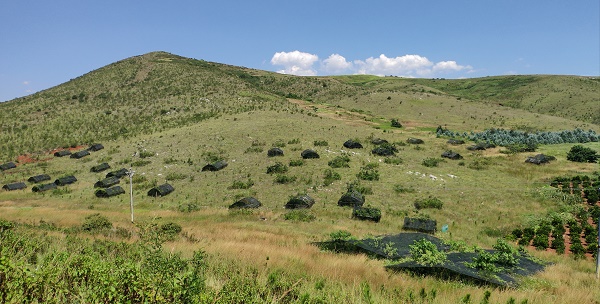Plant propagules (seeds, root fragments, rhizomes, tubers and corms) in soil carry memory information of past, present and even future plant communities. Awakening flora memory from plant propagules in the translocated topsoil from a donor site is a rapid method for forest restoration on degraded sites globally. However, no research has concerned the effect of management techniques on flora memory awakening after topsoil translocation.
In a study published in Restoration Ecology, researchers from Xishuangbanna Tropical Botanical Garden (XTBG) tried to provide a scientific basis for identifying manageable factors for the reforestation of degraded ecosystems.They explored and quantified the effects of multiple levels of light reduction and watering on the cumulative number and richness of plantlets emerging after topsoil translocation in a field experiment.
They carried out experiment at a karst rocky desertification area (23°41′42″N, 102°56′50″E) in Jianshui County, a pilot area for comprehensive rocky desertification control by the state in 2008. They used the quadratic saturation D-optimum design to quantify the response of the cumulative number and richness of emerged plantlets among different life forms to light reduction and watering treatments.
They found that the number and richness of plantlets that can be awakened are crucial for long-term restoration success during topsoil translocation. Any combinations of light reduction and watering increased the number and richness of plantlets across different life forms after topsoil translocation, and light reduction played a more significant role than watering in flora memory awakening.
The cumulative number of plantlets for total species and shrubs exhibited a parabolic relationship with both light reduction and watering treatments. An increase in either the level of light reduction or watering would quickly boost the number of plantlets in the early stages. After reaching a peak, the number of plantlets would then decline at higher levels of light reduction or watering.
“Our findings suggest that the maximum number and richness of plantlets can be achieved with an optimal combination: a light reduction of about 60% to the degraded site and watering to about 80% of the donor site's soil water content. Therefore, restoration strategies should incorporate different light reduction and watering combinations to satisfy the requirements of different species,” said SHEN Youxin of XTBG.


Restored vegetation of a karst rocky desertification area in Jianshui, Yunnan. (Image by CHEN Fajun)
Contact
SHEN Youxin Ph.D
Key Laboratory of Tropical Forest Ecology, Xishuangbanna Tropical Botanical Garden, Chinese Academy of Sciences, Mengla, Yunnan 666303, China
E-mail: yxshen@xtbg.ac.cn
Published: 5 August 2024


